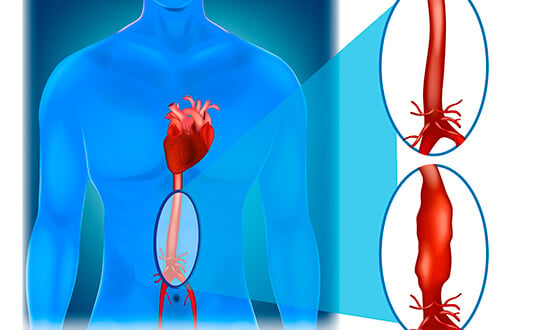Aortic aneurysm is a widely spread illness that is likely to cause harm, which is why it’s vital to understand what is an aortic aneurysm. Aortic aneurysm is a local distension of the corresponding blood vessel. This deviation can be complicated with the excessive bleeding and eventual fatality. Though this illness is highly spread, its diagnosis is not always possible. This happens because aortic aneurysm frequently has an asymptomatic course. Nonetheless, autopsy data show that aneurysms are present in 6% of people around the age of 50 years and over, and 12% of people over the age of 70 years. Not every aortic distension is considered an aneurysm. Diagnosis is established in case the distension is two times broader than the vessel diameter along its entire length. Also, the aortic aneurysm definition is a local protrusion of the artery wall, which threatens its rupture with subsequent bleeding.
Distension can be:
- Saccular (ampullar) when an excavation appears
- Diffuse, when there is an equal expansion of the vessel distension at its certain length
Content
- Aortic aneurysm causes
- Aortic aneurysm classification
- Hospitals and cost of treatment
- Aortic aneurysm treatment in Germany
Aortic aneurysm causes
Pathology can be caused with quite diverse factors. However, certain etiological factors are more common than others. Aortic aneurysm mostly appears as a result of atherosclerosis - more than 80% of all cases of the disease. Atherosclerosis appears when cholesterol plaques are deposited on the walls of the blood vessels. Over time, they expand, harden, and become covered with calcium salts.
All aortic aneurysm causes can be divided into two groups:
- Congenital
- Acquired
Congenital aneurysms can appear due to cardiac defects or diffuse connective tissue diseases. But, aortic aneurysms are mostly acquired.
Besides atherosclerosis the reasons are:
- Iatrogenic (treatment-induced, diagnostic or treatment procedures)
- Traumatic
- Infectious (syphilis, fungal diseases, nonspecific aortitis, infection of the aortic prosthesis)
- Hormonal (necrosis of the vessel's medium during pregnancy)
It’s necessary to highlight aortic aneurysm risk factors which increase the likelihood of this illness:
- Age - the overall prevalence of pathology in the population is about 0.5%, and among people after 70 years it reaches 12% (about 80% of patients are over 60 years old)
- Gender - in men, the disease is diagnosed 8-10 times more often than in women
- Smoking, obesity, hypodynamia and other risk factors for atherosclerosis also increase the likelihood of an aortic aneurysm (these diseases are closely related)
Aortic aneurysm classification
Main criterion for aortic aneurysm classification is its location. Let’s revise what parts the aorta consists of.
Aorta starts at the left heart ventricle, rises a few centimeters up, makes the arch and then goes down. Reaching the diaphragm, the aorta passes through it. Here the thoracic aorta ends and its abdominal part begins. The aorta ends at the point where it divides into the right and left iliac arteries.
Aortic parts:
- Ascending - one that comes out of the heart and goes up
- Aortic arch
- Descending aorta (divided into abdominal and thoracic)
Angiology science says that all aortic parts above the diaphragm belong to the thoracic part of aorta, which is quite logical, given that they are located in the chest cavity. Therefore, aortic aneurysm can be located in its thoracic or abdominal part. Furthermore, each type is divided into subtypes judging on the more precise location of the vessel distension.
Such types of thoracic aortic aneurysms are differentiated:
- Aneurysm of Valsava sinus (aortic root aneurysm). This is a distension of the initial vessel part that comes out of the heart. Pathology is considered as a congenital heart disease
- Ascending thoracic aortic aneurysm
- Aneurysm of aortic arch
- Descending thoracic aortic aneurysm (meaning only thoracic part)
Distensions in the abdominal part of this blood vessel appear much frequently. They make 30-36% of all aneurysms cases.
Disease can be classified into the following types due to its location:
- Aneurysm of the initial abdominal aorta division with the involvement of its branches in the pathological process
- Infrarenal abdominal aortic aneurysm (below the renal arteries):
- branching of the aorta into the arteries may or may not be involved
- the ileum arteries are involved or not
- Overall abdominal aortic affection
Aneurysm of the thoracicoabdominal section is separately distinguished here. This means that the expansion of the vessel begins in the thoracic part and passes to the abdominal area. It often has a great length.
Thoracicoabdominal aneurysms are further distinguished into 4 types:
- Type 1 – distension begins in the upper half of the thoracic aorta and ends above the renal arteries
- Type 2 – distension begins in the upper half of the thoracic aorta and extends below the renal arteries
- Type 3 – distension begins in the lower half of the thoracic part of the aorta, it does not matter where it ends
- Type 4 – an aneurysm starts at the level of the diaphragm and extends to the abdominal part of the aorta
Such classification carries significant importance. The aorta has great length. Location of the aneurysm mainly dictates the clinical picture, prognosis and what treatment techniques to use.
Aneurysm location often defines who will be carrying out a surgery. For instance, ascending thoracic aortic aneurysm will be operated by vascular, thoracic and cardiac surgeons. This matters because ascending thoracic aortic aneurysm is located in the thoracic part, in the immediate vicinity of the heart. At the same time, distension of its abdominal part is often operated by vascular and abdominal surgeons.
Hospitals and cost of treatment
Based on the indicators of treatment success, the availability of modern equipment, the level of cardiac surgeons and cardiologists, we have identified the leading hospitals for the treatment of thoracic aortic aneurysms:
- University Hospital of Ludwig-Maximilian University of Munich, Department of Vascular Surgery
- Charite University Hospital Berlin, Department of General, Abdominal and Vascular Surgery
- University Hospital Carl Gustav Carus Dresden, Department of Abdominal, Thoracic and Vascular Surgery
- University Hospital Frankfurt-am-Main, Department of Vascular and Endovascular Surgery
- University Hospital Heidelberg, Department of Vascular and Endovascular Surgery
The average cost of the main types of treatment is as follows:
- Examination for suspected thoracic aortic aneurysm – €2,730
- Open aortic replacement in thoracic aortic aneurysm – €46,340
- Endovascular aortic replacement in thoracic aortic aneurysm – €47,760
- Rehabilitation after completion of the main course of treatment – €1032 per day
If you need treatment for an aneurysm of another part of the aorta, leave the request at the Booking Health website and a medical advisor will help you with selection of the proper hospital.
Aortic aneurysm treatment in Germany
In case you were diagnosed with aortic aneurysm – it’s better not to wait until your condition will worsen and an aneurysm will rupture. Certain cases demand emergency treatment. Thus, if aortic aneurysm dissection was diagnosed, the risk of death within the next 3 months in the course of the natural course of the disease is about 90%.
You can receive quality treatment in Germany. Booking Health will arrange it for you.
We will provide:
- Early start of treatment
- Choosing the best clinic where you will receive the highest quality of medical services at an affordable price
- Savings of up to 70% of the total costs
- Service (visa processing, translation of medical documents, airline tickets, transfer to the clinic from the airport, etc.)
The original cost of the program is guaranteed not to change, because all unforeseen expenses, if necessary, will be covered by insurance.
Choose treatment abroad and you will for sure get the best results!
Authors:
The article was edited by medical experts, board certified doctors Dr. Nadezhda Ivanisova, Dr. Sergey Pashchenko. For the treatment of the conditions referred to in the article, you must consult a doctor; the information in the article is not intended for self-medication!
Sources:
National Center for Biotechnolog
Read:
Aortic aneurysm – what is it, causes, classification
Don't know where to start?
Contact Booking Health







